A VISITORS GUIDE
to Colonial & Revolutionary
New England.
A VISITORS GUIDE
to Colonial & Revolutionary
New England.
SECOND EDITION
Patricia & Robert Foulke

Copyright 2006, 2012 by Patricia and Robert Foulke
All rights reserved. No part of this book may be reproduced in any form or
by any electronic or mechanical means, including information storage and
retrieval systems, without permission in writing from the publisher,
except by a reviewer, who may quote brief passages.
Library of Congress Cataloging-in-Publication Data is available.
A Visitors Guide to Colonial & Revolutionary New England
ISBN-13: 978-0-88150-969-4
ISSN: 1937-9609
Book design by Joseph Kantorski
Composition by Eugenie S. Delaney
Maps by Paul Woodward, The Countryman Press
Interior photographs by the authors unless credited to other sources.
Published by The Countryman Press, P.O. Box 748, Woodstock, VT 05091
Distributed by W. W. Norton & Company, Inc.,
500 Fifth Avenue, New York, NY 10110
Printed in the United States of America
10 9 8 7 6 5 4 3 2 1
Contents
Acknowledgments
We are particularly grateful for the advice and help of three scholars, all historians who have written about aspects of colonial and Revolutionary New England: Professor John B. Hattendorf, chairman of the Maritime History Department at the Naval War College; Professor Emeritus Tadahisa Kuroda of Skidmore College (now deceased); and Professor Emeritus Benjamin W. Labaree of Williams College. They are not responsible for any errors or omissions, but they led us to important sources and solved a number of specific historical problems.
We also extend our gratitude to many persons who helped us plan our travels through colonial New England, provided maps, arranged appointments, and sometimes reviewed our text. They include directors of local and regional visitors bureaus and chambers of commerce, media specialists in state tourist authorities, public relations representatives and guides at historical sights, friends, and a host of others who went out of their way to give us information and lead us to important sites in their communities.
We also thank Kermit Hummel, editorial director of the Countryman Press, for his interest in this book and the two that followed on the Middle Atlantic States and the South; former managing editor Jennifer Thompson, for her patience as the manuscript grew, and copy editor Glenn E. Novak, for his editorial acumen, knowledge of history, and substantive contributions to the text; and current managing editor Lisa Sacks and copy editor Justine Rathbun, for their careful attention to the shape and substance of the second edition.
Introduction
People who travel walk through human history, whether they are conscious of it or not. In this book we hope to enhance the pleasure of your travel throughout New England by developing and refining a sense of place. Heightened awareness of what happened where we walk now and whose footsteps preceded ours satisfies not only curiosity but also a natural longing to be connected with our surroundings.
Those who profess to live only in the presenta persistent mythical state in American popular cultureforget how disturbed they are when revisiting childhood sites that have changed almost beyond recognition. Constructing the past, and often idealizing it in the process, creates an orientation in time that is inseparable from the sense of place that defines who we are, both individually and collectively. Just as we rewrite our own internal autobiographies year by year, each generation recasts the past in its own molds.
Colonial and Revolutionary history is a kaleidoscope of movement and change, but it is clearly tied to many places that still remain. Rediscovering those places and expanding their meaning is the aim of this book. It is not designed for committed antiquarians or for those who reduce the past to a prologue of the present. It is designed for travelers with a persistent curiosity, those who like to build contexts around what they see.
This book explores colonial and Revolutionary sites, forts, government buildings, churches, inns, houses, historic districts, museums, and living-history museums throughout the six New England states. The time span begins in the early 1600s and extends into the early 1800s.
A Visitors Guide to Colonial & Revolutionary New England combines the features of travel guides and historical narratives to re-create the conditions and ambience of colonial life for hit-the-road travelers and armchair travelers alike. As avid travelers of both sorts ourselves, we hope to bring you a vivid sense of place, time, and character.
Some of the stories are about historical figures you may already know, and others may tickle your fancy. You may enjoy reliving trips already taken, or you may be considering a new venture and want specific information on potential activities and sites within various regions.
A time line at the beginning of each chapter sets the stage for your personal orientation. An introduction describes the founding and development of what became each New England state. Then the focus shifts to places that can still be seen by visitors who want to walk into their heritage to understand it better. Throughout the remainder of each chapter the focus remains on specific places, linking each town and building or site with the events that occurred there. In some cases we may mention the dates of early settlement in a village even if there is little or nothing left to see except the topography. In other cases the process of expanding and modernizing buildings has left a remnant of a colonial home or inn intact after two or three hundred years of addition and change. Those with observant eyes may be able to reconstruct what a place might have looked like in the colonial era and get some sense of how its inhabitants lived.
Our emphasis is less on memorializing important political and military events than understanding the context in which they occurred, so the book includes much material on the social and cultural history of everyday lifearchitecture, clothing, transportation, occupations, religious practices, customs, folklore, and the like. The early groups of colonists left Europe and endured the hardships of living in the wilderness of the New World to attain religious freedom and maintain their own cultures. Often such groups defined religious and social practices narrowly, expelling those who would not conform. And sometimes rigid rules in one colony created another, as in the case of Massachusetts Bay spawning Rhode Island.
Thus the idea of a quintessential colonial America is itself more a convenience for historians than a reality. In fact, there were many disparate settlements that gradually and often reluctantly banded together for limited common purposes. Since the New England colonies were quite diverse in topography and economic activity, with peoples drawn from different ethnic, regional, and religious traditions in Europe, the story has to be retold for each within the larger framework of American expansion. The process of their amalgamation lasted through the Revolution and beyond, eliciting much controversy and sometimes bumptious behavior. Regionalism, by no means dead today, persisted throughout the colonial and Revolutionary eras and blocked many attempts at cooperation among the colonies.
Also, many early European attempts to establish colonies in America were dismal failures, often because the entrepreneurs and adventurers who came were bent on exploiting the new land. Those with money to invest in shares were not used to hard work and often ill equipped for the rigors of living in the wilderness. Some of these failed ventures in New England, like the 1607 Popham colony at the mouth of the Kennebec River in Maine, became footnotes in the history of colonization. Even among the settlements that survived and prospered, some were abandoned later as economic or political conditions changed. Permanence, order, and stability were envisioned in royal charters but seldom realized in the early history of colonies.
Next page







